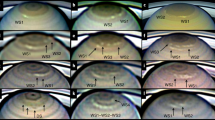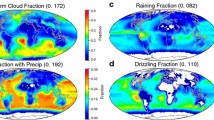Summary
We examine a family of tall (up to 20 km) cumulonimbus complexes that develop almost daily over an adjacent pair of flat islands in the Maritime Continent region north of Darwin, Australia, and that are known locally as “Hectors”. Nine cases observed by a rawinsonde network, surface observations (including radiation and soil measurements), the TRMM/TOGA radar, and one day of aircraft photography are used to analyse the development, rainfall, surface energy budgets, and vertical structure of these convective systems.
The systems undergo convective merging which is similar to that observed in previous Florida studies and is multiplicative in terms of rainfall. About 90% of the total rainfall comes from the merged systems, which comprise less than 10% of convective systems, and this has implications for the manner in which tropical rainfall is parameterised in largerscale numerical models. By comparison to the West Indies, GATE, and Florida, the Hector environment contains a weaker basic flow, with less vertical shear. The main thermodynamic difference is that the Darwin area has an unstable upper troposphere and very high tropopause. Numerical modelling results support earlier observations of updraughts in excess of 30 ms−1 in this region, but show that only modest convective drafts are experienced below the freezing level (5 km).
The surface fluxes over the islands are estimated from a Monash University study to be mainly in latent form from evapotranspiration, with a Bowen ratio only slightly larger than that commonly observed over oceans. These surface fluxes are crucial to the development of a suitable mixed layer to support deep convection. The flux estimates agree with the observed changes below the cloud base and provide sufficient information for calculations of the bounds on precipitation efficiency. Of particular interest are the observations of Hector development on a day when the islands were under a dense cirrus overcast. We find that the islands still provide sufficient net sensible and latent heat fluxes to initiate convection.
Similar content being viewed by others
References
Adler, R. F., Negri, A. J., 1987: Satellite and radar estimates of convective and stratiform rainfall in south Florida and surrounding regions. Preprint Vol., 17th Amer. Meteor. Soc. Conf. on Hurricanes and Tropical Meteorology, April 7–10, 1987, Miami, Fl., 7–10.
Atlas, D., Rosenfeld, D., Wolff, D. B., 1993: On C-Band attenuation by tropical rainfall in Darwin, Australia, using climatologically tuned Ze-R relations.J. Appl. Meteor. (in press)
Bhumralkar, C., 1973a: An observational and theoretical study of atmospheric flow over a heated island Part I.Mon. Wea. Rev. 101, 719–730.
Bhumralkar, C., 1973b: An observational and theoretical study of atmospheric flow over a heated island Part II.Mon. Wea. Rev.,101, 731–745.
Burpee, R. W., Dodge, P. F., 1992: Analyses of visible satellite imagery of the south Florida sea-breeze circulation.Prep. Fifth Conf. on Mesoscale Proc. Atlanta, January 5–10, 1992: American Meteorological Society, Boston, MA, 77–80.
Cooper, H. J., Garstang, M., Simpson, J., 1982: The diurnal interaction between convection and peninsular-scale forcing over south Florida.Mon. Wea. Rev.,110, 486–503.
Ferrier, B. S., Houze, R. A., 1989. One-dimensional time-dependent modelling of GATE cumulonimbus convection.J. Atoms. Sci.,46, 330–352.
Holle, R. L., Cunning, J., Thomas, J., Gannon, P., Teijeiro, L., 1977: A case study of mesoscale convection and cloud merger over south Florida. Proc. 11th Tech. Conf. on Hurricanes and Tropical Meteorology. Dec. 13–16, 1977, Miami Beach, FL. Am. Meteor. Soc., Boston.
Houze, R. A., 1989: Observed structure of mesoscale convective systems and implications for large-scale heating.Quart. J. Roy. Meteor. Soc.,115, 425–461.
Houze, R. A., Geotis, S. G., Marks, F. D., West, A. K., 1981. Winter monsoon convection in the vicinity of north Borneo. Part I: Structure and time variation of the clouds and precipitation.Mon. Wea. Rev.,109, 1595–1614.
Jordan, C. L., 1985: Mean sounding for the West Indies area.J. Appl. Meteor.,15, 91–97.
Keenan, T. D., Holland, G. J., Manton, M. J., Simpson, J., 1988: TRMM ground truth in a monsoon environment: Darwin, Australia.Aust. Met. Mag.,36, 81–90.
Keenan, T. D., Morton, B. R., Manton, M. J., Holland, G. J. 1989: The Island Thunderstorm Experiment (ITEX) — A study of tropical thunderstorms in the maritime continent.Bull. Amer. Meteor. Soc.,70, 152–159.
Keenan, T. D., Morton, B. R., Zhang, X. S., Nyguen, K., 1990: Some characteristics of thunderstorms over Bathurst and Melville Islands near Darwin, Australia.Quart. J. Roy. Meteor. Soc. 116, 1153–1172.
Lin, Y.-L., Farley, R. D., Orville, H. D., 1983: Bulk parameterization of the snow field in a cloud model.J. Climate Appl. Meteor. 22, 1065–1092.
Oye, R., Carbone, R., 1981: Interactive Doppler editing software Preprint Vol. 20th AMS Conf. on Radar Meteor., Nov. 30-Dec. 3, 1981, Boston, MA, 683–689.
Malkus, J. S., Stern, M. E., 1953: The flow of a stable atmosphere over a heated island. Part I.J. Meteor.,10, 30–41.
McCumber, M. C., 1980: A numerical simulation of the influence of heat and moisture upon mesoscale circulations. Ph.D. dissertation, Dept. Env. Sci., Univ. Virginia, 255 pp. On file with author, Severe Storms Branch, GSFC/NASA, Greenbelt, MDS 20771, U.S.A.
Monteith, J. L., 1975:Vegetation and the Atmosphere. New York: Academic Press, p. 99ff.
Pielke, R. A., 1974: A three-dimensional numerical model of sea breezes over south Florida.Mon. Wea. Rev.,102, 115–139.
Rosenfeld, D., Atlas, D., Wolff, D. B., Amitai, E., 1992. Beam-width effects on Z-R relations and area-integrated rainfall.J. Appl. Meteor. 31, 454–464.
Short, D. A., Kozu, T., Nakamura, K., 1990: Rainrate and raindrop size distribution observations in Darwin, Australia. Proc. URSI Commission F Open Symposium on Regional Factors in Predicting Radiowave Attenuation due to Rain. Rio de Janeiro, Brazil 3–7 Dec., 1990, 35–40.
Simpson, J., 1980: Downdrafts as linkages in dynamic seeding effects,J. Appl. Meteor.,19, 477–487.
Simpson, J., 1983: Cumulus clouds: Interactions between laboratory experiments and observations as foundations for models.Mesoscale Meteorology-Theories. observations and Models. Dordrecht: Reidel Publishing Co., 399–412.
Simpson, J., Woodley, W. L., 1971: Seeding cumulus in Florida: New 1970 results.Science. 176, 117–126.
Simpson, J., Woodley, W. L., 1975: Florida Area Cumulus Experiments 1970–1973 rainfall results.J. Appl. Meteor.,14, 734–744.
Simpson, J., Westcott, N. E., Clerman, R. J., Pielke, R. A., 1980: On cumulus mergers.Arch. Met. Geoph. Bioci., Ser. A,29, 1–40.
Simpson, R. H., 1978: On the computation of θE.Mon. Wea. Rev.,106, 124–130.
Skinner, T.C.L., 1990: A study of the sea breeze over Melville and Bathurst Islands and its role in the development of island thunderstorms. Dissertation for Bachelor of Arts (Honours), Department of Geography, Monash University.
Starr, D., Cox, S. K., 1985a: Cirrus clouds, 1, A cirrus cloud model.J. Atmos. Sci. 42, 2663–2681.
Starr, D., Cox, S. K., 1985b: Cirrus clouds, 2, Numerical experiments on the formation and maintenance of cirrus.J. Atmos. Sci.,42, 2682–2694.
Stern, M. E., Malkus, J. S., 1953: The flow of a stable atmosphere over a heated island. Part II.J. Meteor.,10, 105–120.
Stull, R. B., 1988:An Introduction to Boundary Layer Meteorology. Dordrecht, Netherlands: Kluwer Academic Publishers, 666 pp.
Tao, W.-K., Simpson, J., 1984: Cloud interactions and merging: numerical simulations.J. Atmos. Sci. 41, 2901–2917.
Tao, W.-K., Simpson, J.: 1989: A further study of cumulus interactions and mergers: Three-dimensional simulation with trajectory analyses.J. Atmos. Sci.,46, 2974–3004.
Tapper, N. J., 1988: Surface energy balance studies in Australia's seasonally wet tropics: results from AMEX Phase I and II.Aust. Meteorol. Mag.,36, 61–68.
Webster, P. J., Houze, R. A. Jr., 1991: The Equatorial Mesoscale Experiment (EMEX): An overview.Bull. Amer. Meteor. Soc.,72, 1481–1505.
Wiggert, V., Ostlund, S., 1975: Computerized rain assessment and tracking of south Florida WSR-57 weather radar echoes,Bull. Amer. Meteor. Soc.,56, 17–26.
Wilson, J. W., Schreiber, W., 1986: Initiation of convective storms at radar observed boundary-layer convergence lines.Mon. Wea. Rev.,114, 2516–2536.
Woodley, W. L., Olsen, A. R., Herndon, A., Wiggert, V., 1975: Comparison of gage and radar methods of convective rain measurement.J. Appl. Meteor. 14, 909–928.
Woodley, W. L., Simpson, J., Biondini, R., Berkeley, J., 1977: Rainfall results: 1970–1975: Florida Area Cumulus Experiment.Science,195, 735–742.
Author information
Authors and Affiliations
Additional information
With 10 Figures
Rights and permissions
About this article
Cite this article
Simpson, J., Keenan, T.D., Ferrier, B. et al. Cumulus mergers in the maritime continent region. Meteorl. Atmos. Phys. 51, 73–99 (1993). https://doi.org/10.1007/BF01080881
Received:
Issue Date:
DOI: https://doi.org/10.1007/BF01080881




